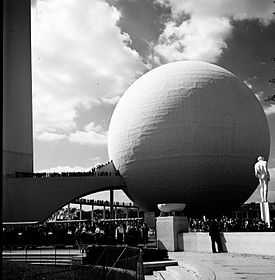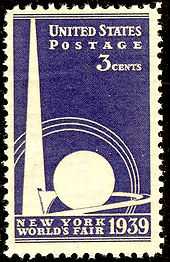Trylon and Perisphere


The Trylon and Perisphere were two modernistic structures, together known as the "Theme Center," at the center of the New York World's Fair of 1939-1940. Connected to the 610-foot (190 m) spire-shaped Trylon by what was at the time the world's longest escalator, the Perisphere was a tremendous sphere, 180 feet in diameter. The sphere housed a diorama called "Democracity" which, in keeping with the fair's theme "The World of Tomorrow", depicted a utopian city-of-the-future. Democracity was viewed from above on a moving sidewalk, while a multi-image slide presentation was projected on the interior surface of the sphere. After exiting the Perisphere, visitors descended to ground level on the third element of the Theme Center, the Helicline, a 950-foot-long (290 m) spiral ramp that partially encircled the Perisphere.
The Trylon and Perisphere became the central symbol of the 1939 World's Fair, its image reproduced by the millions on a wide range of promotional materials and serving as the fairground's focal point.[1] The United States issued a postage stamp in 1939 depicting the Trylon and Perisphere (pictured). Neither structure survives; however, the Unisphere, the symbol of the 1964-65 New York World's Fair, is now located where the Perisphere once stood.
The Theme Center was designed by architects Wallace Harrison and J. Andre Fouilhoux, with the interior exhibit by Henry Dreyfuss. The structures were built in Flushing Meadows Park in Queens, New York and were intended as temporary with steel framing and plaster board facades. Both buildings were subsequently razed and scrapped after the closing of the fair, their materials to be used in World War II armaments.

The name "Perisphere" was coined using the Greek prefix peri-, meaning "all around", "about", or "enclosing". The name "Trylon" was coined from the phrase "triangular pylon".
In popular culture
Composer (and Rhapsody in Blue orchestrator) Ferde Grofe was commissioned by the World's Fair to compose a piece of symphonic music dedicated to the sculptured edifices.
The Trylon is mentioned in the 1939 Yip Harburg song "Lydia the Tattooed Lady", made famous by Groucho Marx in At The Circus.
In the 1940 Disney feature Pinocchio, the exterior of the pool hall on Pleasure Island is a ball and cue modeled on the Trylon and Perisphere.
The Trylon Theatre, located on Queens Boulevard in Forest Hills, Queens, New York, operated from December 1939 through December 1999. The theatre's decor included several references to the 1939-40 World's Fair.
In the 1942 WB cartoon "Crazy Cruise", the Trylon and Perisphere are jokingly presented as being part of the pyramids of Egypt.
The episode The Odyssey of Flight 33 of The Twilight Zone featured a view of these structures from the air to indicate that a Boeing 707 had time traveled and had arrived in the year 1939 or 1940.[2]
Trylon and perisphere are mentioned as generic concepts by the main character as he is introduced in the beginning of Robert Silverberg's 1972 novel Dying Inside.
In the DC Comics comic book series All-Star Squadron (debuting in 1981), the Squadron used the Perisphere as their headquarters.
Howard Waldrop's 1985 short story "Heirs of the Perisphere" describes the excavation of the time capsule which was buried at the 1939 World's Fair.
In Robert Stone's novel Outerbridge Reach (copyright 1992), the deconstruction of the Trylon and Perisphere is seen as an allegory for America's sacrifice in World War II.
Singer/songwriter Aimee Mann created a song called "Fifty Years After the Fair" for her 1993 album Whatever, the subject of which is the 1939 World's Fair. The song references the Trylon and Perisphere while suggesting how little of the Fair's bright vision of the future had actually been realized in the "decades ahead" now passed.
In the 1995 episode Aubrey of the TV series The X-Files, the protagonist has visions of Trylon and perisphere leading the detectives to an important clue.
A photo of visitors on the walkway between the two structures is used as the cover art of the 2000 album Deltron 3030.
In the 2004 movie Sky Captain and the World of Tomorrow, whose title references the fair, two structures which resemble the Trylon and Perisphere are briefly seen in the Himalayas.
In Michale Chabon's novel The Amazing adventures of Kavalier and Clay Sammy visits the Perisphere with his lover Bacon.
See also
- Skylon (tower) at the 1951 Festival of Britain
References
- ↑ Harrison, Helen. "Stuart Davis' 'World of Tomorrow.' American Art, Vol. 9, No. 3. (Autumn, 1995), pp. 96-100.
- ↑ The Odyssey of Flight 33
Further reading
- Cohen, Barbara. Trylon and Perisphere. Harry N. Abrams, Inc. Publishers, New York, 1989.
- Gelernter, David. 1939: The Lost World of the Fair. The Free Press, New York, 1995.
- Newhouse, Victoria. Wallace K. Harrision, Architect. Rezzoli International Publications Inc. New York, 1989.
- "New York World's Fair, 1939." Architectural Forum, June 1939. vol. 70, pp. 393–462.
- "The World's Fair will put on a 6-minute show inside its perisphere." Life, August 1938. pp. 55–58.
- "Aerodynamics of the Perisphere and Trylon at World's Fair." American Society of Civil Engineers, Vol. 65 Issue 5, 1938. pp. 887–906.
External links
Coordinates: 40°44′47″N 73°50′42″W / 40.7463°N 73.8451°W